How to Find Makeup Influencers for Your Beauty Brand
Finding makeup influencers is an ongoing process for beauty brands in constant need of UGC. We dig into how to find beauty content creators for any...
It’s no secret that skincare marketing is competitive. Our guide to skincare social media covers content ideas and tips to help beauty brands grow & glow!
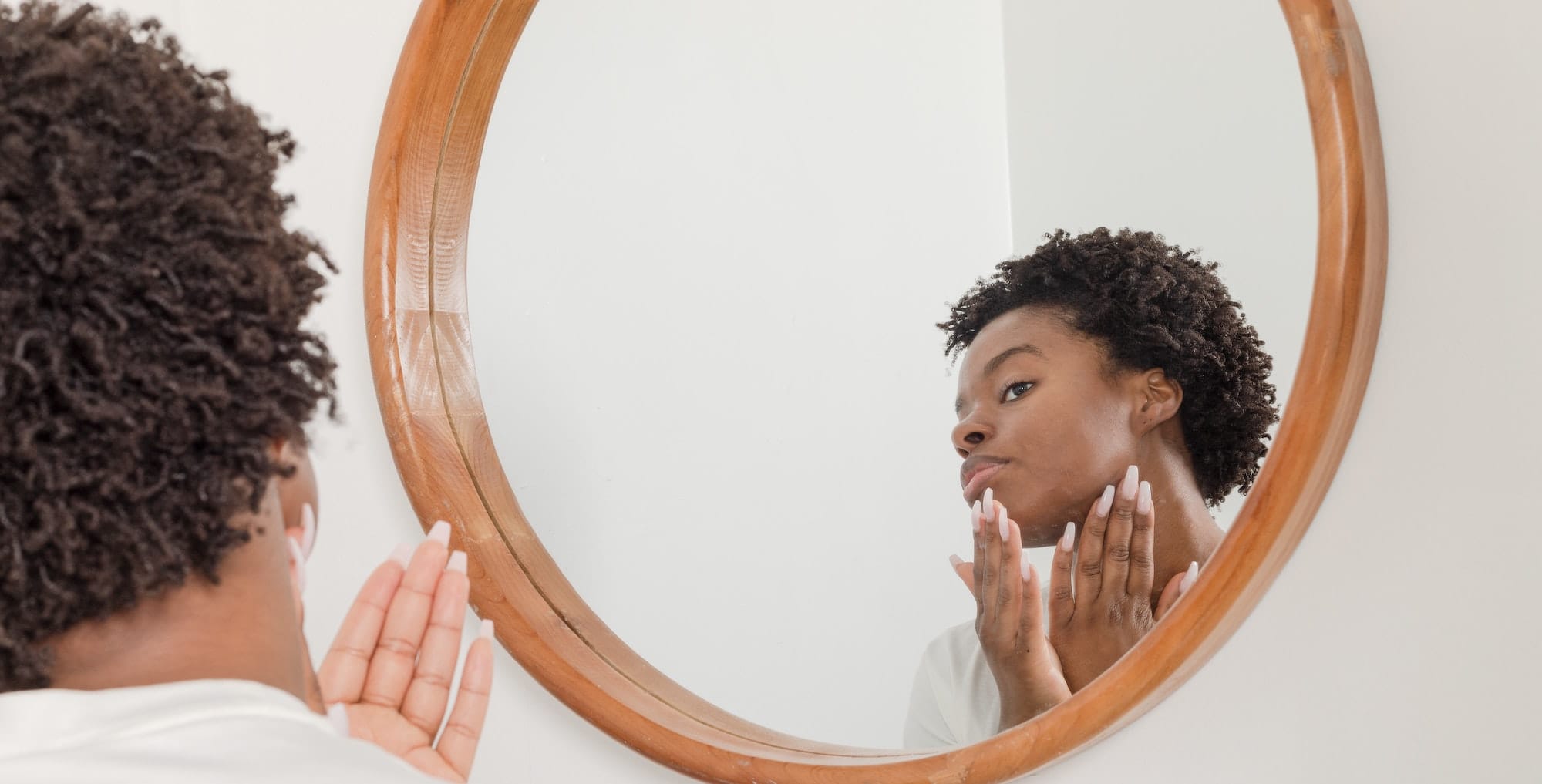
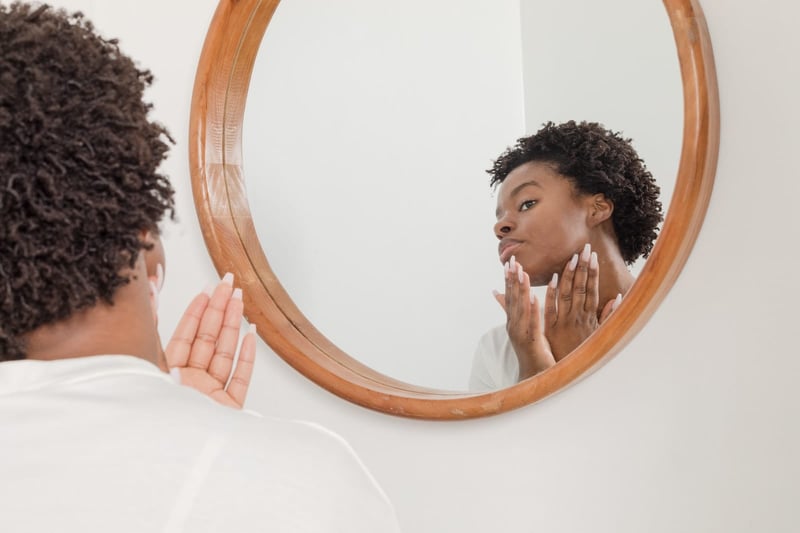
We can’t think of an industry more synonymous with social media than skincare.
Spend a minute on Instagram or TikTok and you’re bound to encounter beauty brands. Skincare marketing offers brands endless creative freedom and opportunities to win new customers.
Eye-popping tutorials. New product drops. Tips from makeup artists. The list goes on and on!
The problem? The skincare space is seriously crowded.
Skincare brands must maximize their time spent creating content and interacting with customers. Below are the fundamentals of skincare social media marketing and proven content ideas to help you do just that!
👉 Learn how your brand can scale beauty influencer collabs with Statusphere's platform!
First thing's first: you need to prioritize the social platforms where your customers hang out.
The thing is, skincare social media marketing is fair game on all of the major networks.
The priority platforms for beauty brands right now are Instagram, TikTok and YouTube. Let’s look at why these three networks deserve your undivided attention.
A whopping 85% of beauty professionals claim Instagram is their go-to social media platform.
We totally understand why, though.
Instagram’s aesthetic grid is perfect for polished product photos and videos. When done right, your Instagram presence serves as a flawless digital shopping window.
Content formats such as Stories and Reels provide creative avenues to show off your products and educate customers, too. Coupled with product tagging and social shopping features, skincare brands can drive sales directly from Instagram.
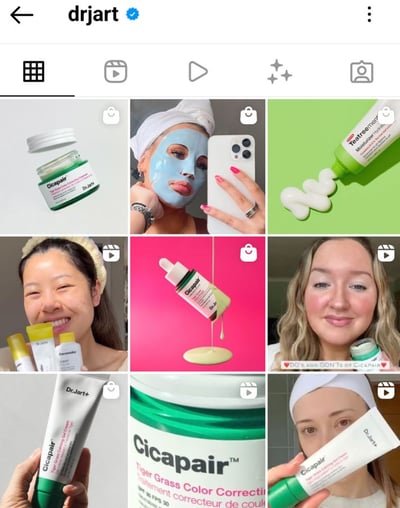
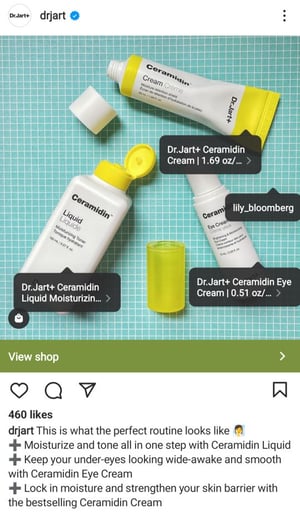
Source: @drjart
Don’t ignore the popularity of TikTok “skinfluencers!”
Skincare hacks, reviews and product shout-outs dominate the platform. From #DermDoctor to #FoundationHacks, there are countless skincare niches for brands to reach. Given that beauty hashtag usage grew by 186% on TikTok last year, the community is only getting bigger.
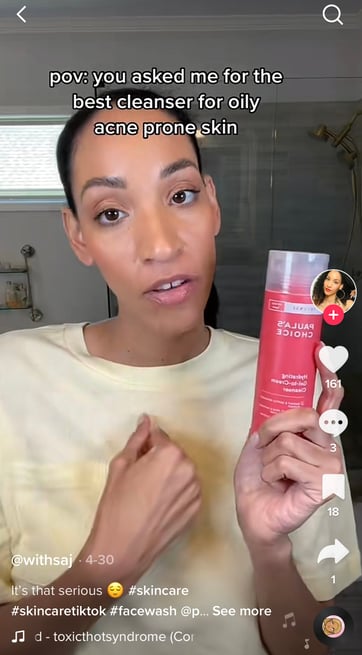
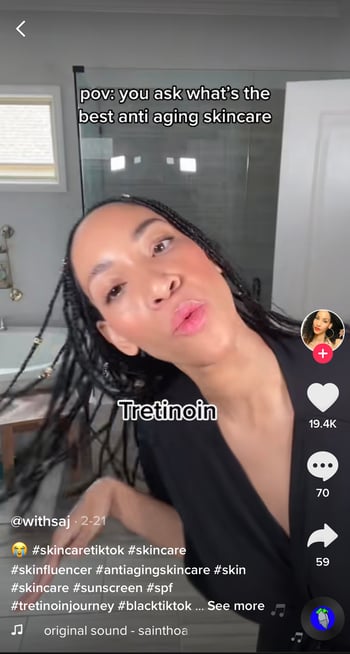
Source: @withsaj
From #sponsored reviews to makeup artist round-ups, YouTube remains one of the best skincare marketing channels for brands.
Google themselves noted that 86% of the top beauty videos on YouTube come from creators versus professional accounts a few years back. Fast forward to the present day and organic creator content still crushes it on the platform.
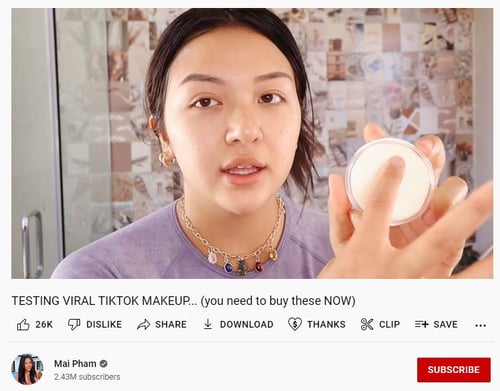
Source: Mai Pham
Skincare brands have plenty of options when it comes to advertising. Still, juggling multiple social media channels is tough. This is especially true if your brand is late to the party and you’re starting a social presence from scratch.
Our advice? Start by prioritizing your Instagram and TikTok. Both networks are booming for beauty brands and creators alike. Chances are your customers are already there in droves.
Beyond that, there’s plenty of overlap between the platforms’ audience and content types. Think about how Instagram Reels and TikTok videos can easily be tweaked and repurposed for either platform. This is a great example of how to squeeze more out of your content strategy.
|
👋 Read to collab with skincare influencers at scale? Watch how Statusphere's platform makes it possible to find 1,000s of vetted beauty influencers in a fraction of the time! 👀 |
Let’s say you’ve established your company’s social accounts and are ready to start posting.
Nice! Where do you start, though?
Based on our recent 2025 Micro-Influencer Benchmark Report, beauty and skincare brands are posting a wide variety of content but put short-form videos first. 
Below are the types of posts that can serve as the cornerstone of your skincare social media marketing efforts. These posts are awesome for beauty content and can help you boost your brand’s organic reach.
Short-form video is all the rage right now and Reels are no exception.
Why are so many brands using Reels, though? Consider that:
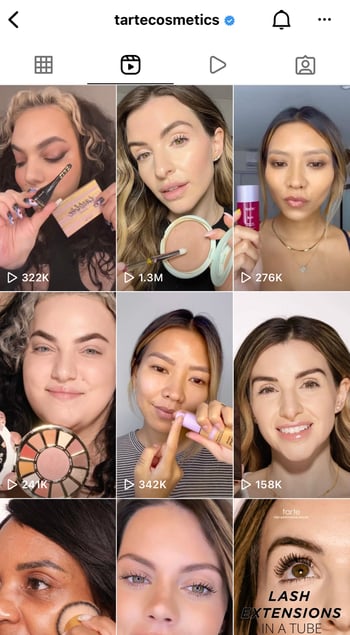
Source: @tarte
In a competitive industry like skincare, anything you can do to earn reach and engagement is a plus. Reels are a proven way to drive discussion and get discovered.
TikTok’s takeover of the beauty industry is impossible to deny. Spend 5 minutes on TikTok and you'll uncover countless skincare post ideas you can adapt yourself with just a smartphone.
Everyday TikTokers and creators are constantly sharing their favorite products, hacks and tips.
Oh, and they’re also earning millions of views in the process.
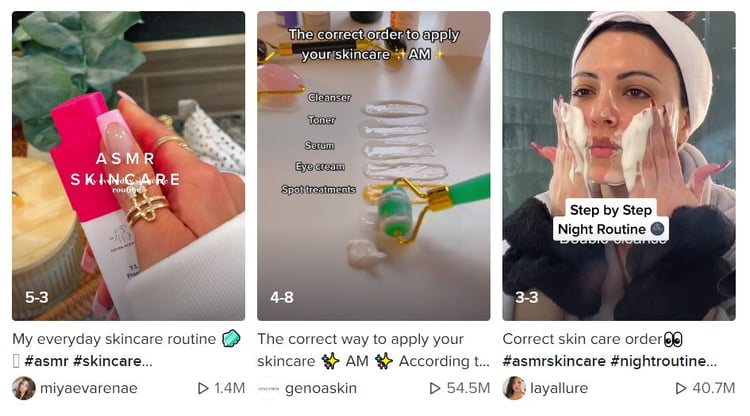
Source: TikTok
Food for thought: 67% of TikTokers are influenced to shop even when they weren’t looking to. Getting featured as a go-to product on TikTok starts with having customers shout you out. While the platform is popular for influencer marketing, the power of everyday creators on the platform is clear.
Don’t sleep on Instagram Stories!
Although the format may have taken a backseat to Reels for many brands, Stories are a proven path to great Instagram engagement. Consider the features built into Stories that drive interactions between brands and customers. This includes:
If you’re looking for skincare Instagram Story ideas, polls are a prime starting point.
For example, what are your customers’ favorite products? Ingredients? How intense is their skincare routine? How do they feel about your latest launch?
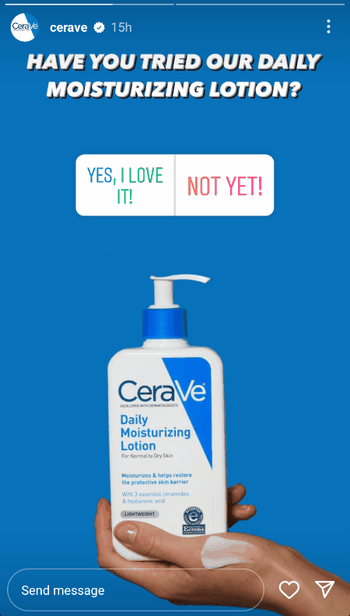
Source: @cerave
Heck, 57% of Instagram users claim they enjoy being polled by brands. Coming up with questions provides an opportunity to gather customer insights and engage followers at the same time.
Did you know that Carousel (slideshow) posts technically have the highest engagement rate of any type of Instagram content?
Aside from high engagement, Carousels serve as a way for brands to provide legitimate value to their followers. Some skincare marketing ideas involving Carousels include:
That only scratches the surface, too! From education to entertainment value, skincare brands are spoiled for choice when it comes to slideshow ideas.
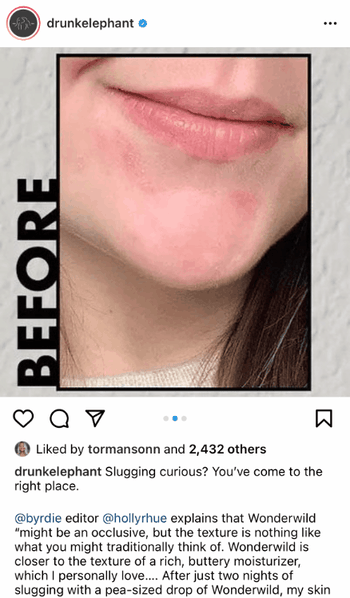
Source: @drunkelephant
Even if you don’t have an active YouTube channel yourself, working with creators on the platform is a great way to gain exposure. Getting an authentic shout-out from a YouTube creator is a huge accomplishment for beauty brands.
Google themselves has emphasized how well #sponsored content on YouTube performs for brands. In a skincare marketing case study for Schick, the brand cited a 229% lift in ad recall and 113% lift in purchase intent. This all happened through sponsored influencer videos that resembled organic content.
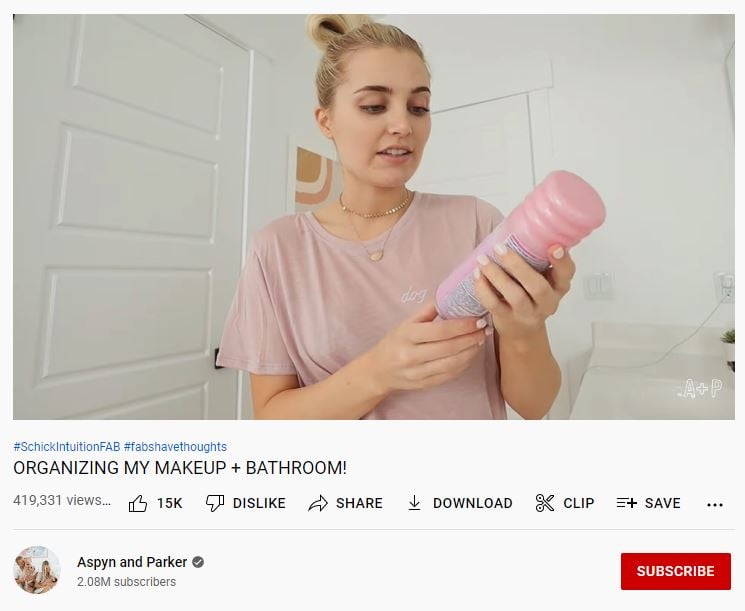
Source: Aspyn and Parker
That’s because beauty buyers rely on YouTube for in-depth reviews, explainers and how-tos. YouTube content is valuable because it’s more static than social videos. In other words, you’re more likely to attract ongoing, long-term business from the platform.
With a better grasp on platforms and posts, it’s time to dive deeper into content ideas.
Again, the skincare space offers a ton of freedom to brands. With so many opportunities to flex your creative muscles, you should never feel stuck in a box.
But creative freedom can also be overwhelming if you’re growing your account from scratch.
Don’t panic! Start by focusing on skincare content that:
Below are five types of content that should be staples of any skincare social media account. No matter your product or niche, you can put your creative trademark on any of the following.
Seeing is believing for consumers.
That’s because potential customers want to be reassured of results. Chances are you’ve been disappointed by a promising product in the past, right? The same rings true for your audience.
Before and after content is powerful because it provides a much-needed sense of proof. That is, proof that your products deliver. Check out this brilliant before and after video from Tula highlighting their acne toner pads.
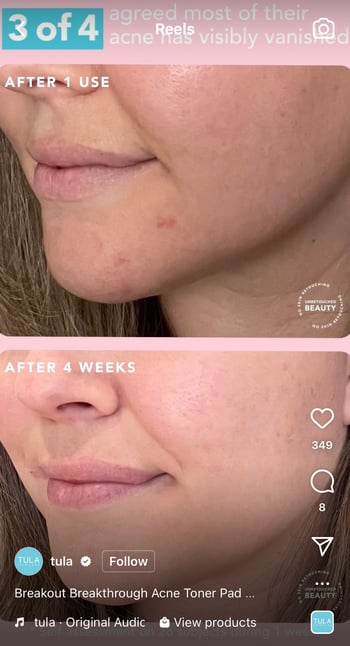
Source: @Tula
Note how the creator behind this video depicts visible results. Not only that but the authenticity and vulnerability on display here are powerful. After all, few people are willing to show off their skincare progress on camera. This highlights the power of real content from creators versus promo photos.
Before and after content is arguably the best way to sell skincare products on social media. Consumers want to see real results and this format is the perfect way to showcase them.
Pop quiz: when’s the last time you made a skincare purchase without reading the label?
Now more than ever are putting ingredients first when it comes to beauty products. In fact, skincare ingredient searches have grown by over 229% year-over-year. Ingredient explainer content serves to educate customers and ease their minds when it comes to what they’re putting on their skin. This includes:
For example, Versed is known for their dedication to clean formulas. Check out their informative “ingredient cheat sheet” on Instagram below: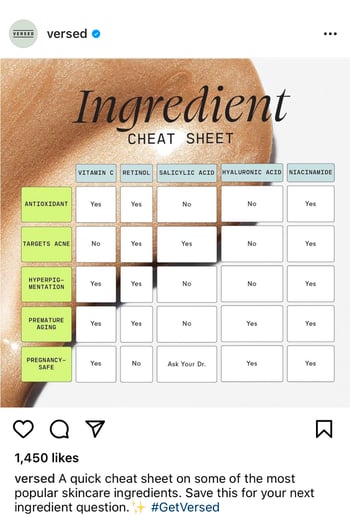
Source: @versed
This is a shining example of how to weave customer education into your skincare social media posts. Here’s another example from Herbivore that combines customer education with a sense of style.
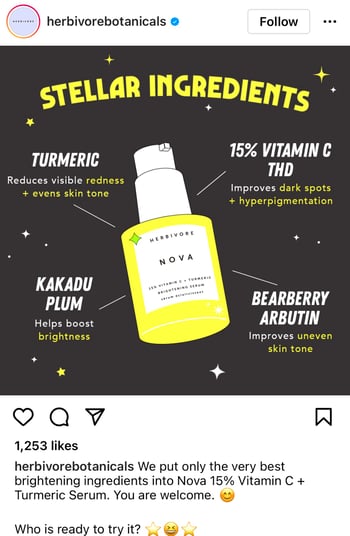
Source: @herbivorebotanicals
Ingredient keywords and phrases can also increase your brand’s visibility in social searches. This includes terms like “vegan,” “natural”, “organic” or “cruelty-free.”
Oh, and use ingredient explainer content to highlight your competitive advantage!
For example, clean skin brands often harp on harmful parabens and irritants to steer clear from. With skincare consumers becoming loyal to ingredients versus brands, don’t be shy about hyping up what’s in your products.
Reviews are always a safe bet for skincare social media content.
After all, 99.9% of consumers claim to read some form of review when shopping online.
For skincare products, reviews can be make-or-break. Customers aren’t afraid to get savage and tear into underwhelming products that didn’t deliver. On the flip side, people will totally gush over products that save their skin (literally).
If someone does give you a positive shoutout on-site or through a third-party review, be sure to promote it as part of your social media content. This is a seamless way to repurpose your UGC.
Here’s an example from Glossier, using a review to hype up the restock of their You Solid Perfume.
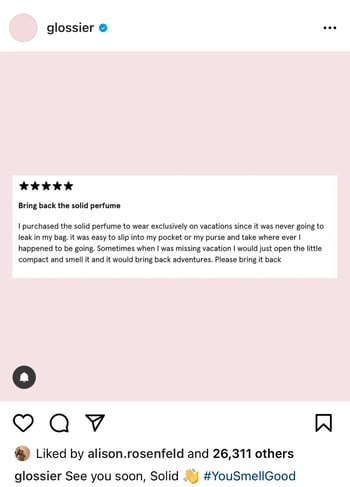
Source: @glossier
Keep in mind that reviews can take forms beyond text. For example, consumers might take to TikTok to rave about how your product cleared their acne or otherwise blew them away.
Social testimonials are arguably even more powerful than text reviews. That’s because they’re authentic, off-the-cuff and real. If your brand is earning shout-outs from customers, integrate that feedback into your social strategy ASAP.
When in doubt, show people how your products work.
This means showcasing actual results and the step-by-step process of how to get those results. For example, you should show customers:
For example, Versed’s TikTok presence includes tons of how-tos and tutorials that teach customers the basics of using their products.
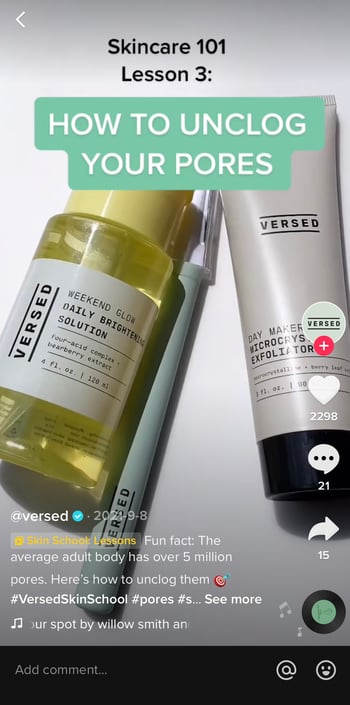
Source: @versed
These types of posts are especially helpful if you have products that might not be self-explanatory.
What do we mean? Note that skincare social media marketing involves reaching customers at various levels of awareness. Some people might already love your brand and products, sure. Others might be seeing you for the first time and don’t understand exactly what you’re selling.
As a result, your social media content should speak to those unaware audiences.
For example, not everyone is going to know what a dermaplaning tool is (see below). That’s okay! Consider how a video could illustrate why that particular product might be useful to someone, though. If you want to highlight products people never knew they needed, how-tos can do the trick.
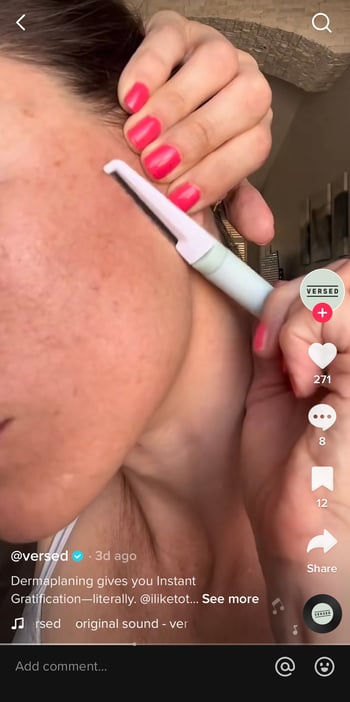
Source: @versed
The key takeaway here? Videos and tutorials make it easier for people to imagine your products in their hands. Likewise, these posts make your product’s positive results more tangible.
With so much competition out there, engaging social followers is no small feat.
That said, challenges and giveaways can give your brand the engagement lift it needs. There’s a reason why these posts are among the most engaged-with skincare social media content.
People can’t resist the power of “free!” The chance to win products or swag is always a strong incentive to get people to post. As an added bonus, contests can earn you valuable user-generated content to promote over and over again.
Following the launch of Ole Henriksen’s Plunge Pore Remedy Moisturizer, the brand took to TikTok to announce a giveaway. All followers had to do was follow the account and tag a friend.
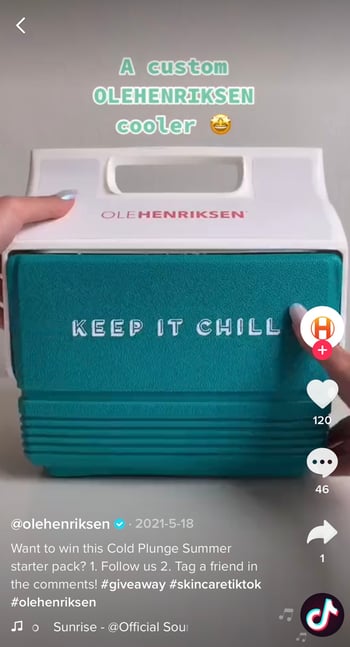
Source: @olehenriksen
Another awesome way to promote your giveaways and challenges is by featuring creators! Creator-based content is proven to increase reach and engagement across social media.
Whether a creator is sharing their own how-to with your products or their own before and after, your brand can piggyback on their audiences.
We’ll say it again: competition in skincare social media is fierce.
Standing out from the crowd might seem impossible. That’s why niching down should be one of your key objectives.
The takeaway? Don’t present yourself as just another skincare brand! Embrace what makes your product and audience different. For example, are all of your products organic? Vegan? CBD-infused? Cruelty-free?
Also, think about your:
Look at a brand like Hempz for inspiration. From their logo to their bio and social content itself, they're totally upfront when it comes to how they’re all about hemp seed oil. They’ve attracted a dedicated Instagram audience of over 73,000 followers by doing just that.
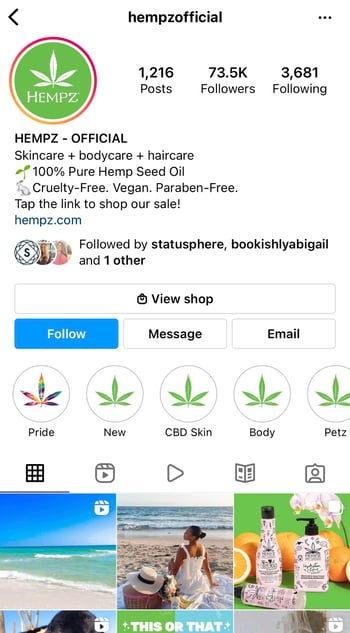
Source: @hempz
Don’t worry about trying to compete with big box brands boasting millions of followers. Carving out your niche is crucial to growing your audience in a crowded space.
The more targeted your messaging is, the more you can tap into your audience's pain points and challenges. This creates a much-needed sense of trust and empathy.
For example, Statusphere's beauty influencer platform uses 250+ first-party data points to match brands and creators within our network. This is invaluable for skincare brands where there are so many factors that influence whether a product is a good fit for a creator.
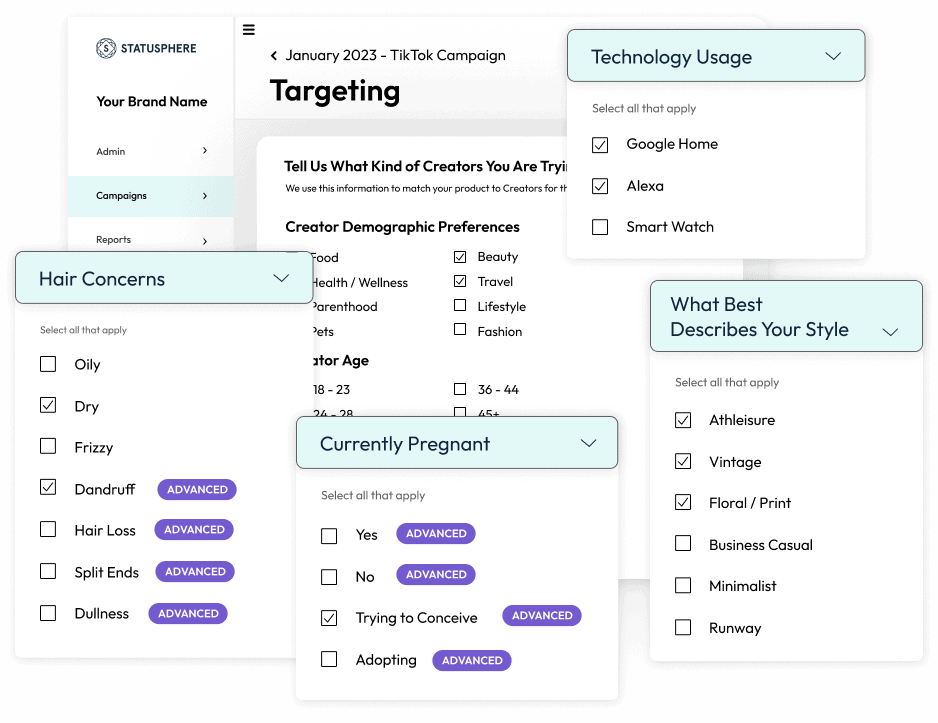
With your content strategy squared away, it’s time to think about day-to-day interactions with your followers. The more valuable touchpoints you make with followers, the easier it is to translate your skincare social media strategy into sales and loyalty.
The modern customer journey involves bouncing between multiple platforms and researching multiple brands before making a purchase. Chances are there are followers on the fence about buying from you but need one last little push.
To wrap things up, let’s look at some bonus activities you can do to delight your followers.
From your best products to future skincare content ideas, your customers are your best source of inspiration. Make a point to consciously take note of their suggestions and respond to thoughtful comments. This shows that you care and also makes a positive impression on your audience.
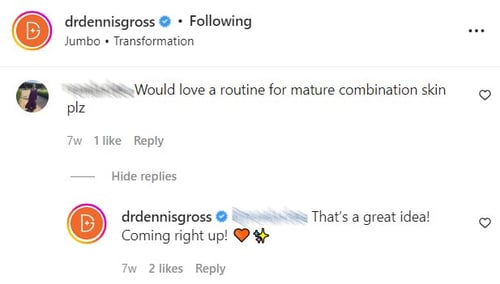
Source: @drdennisgross
Skincare social media is about so much more than just posting about your products. Consider that channels like Instagram often serve as a secondary customer service channel for brands.
After all, it’s much easier to get a brand’s attention via public Instagram comments versus email or a lengthy feedback form on your company site. If someone asks a question, make a point to provide a personalized response. This is especially important when it comes to recommending products.
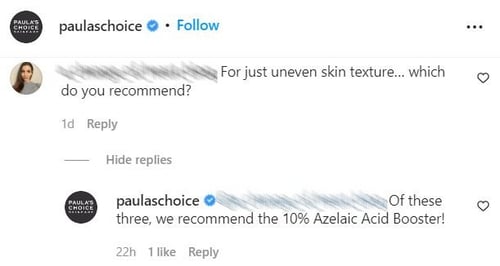
Source: @paulaschoice
Also, note that if one person is asking a question there’s a good chance that others are thinking about asking it. Again, thoughtful responses can make a lasting impression.
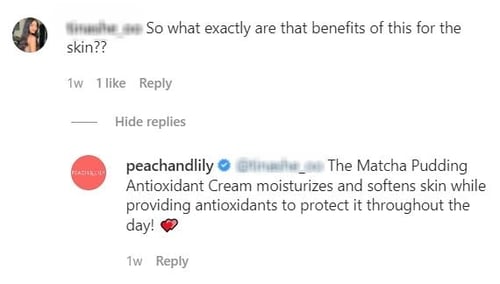
Source: @peachandlily
Impacting purchasing decisions for 79% of consumers, user-generated and influencer content (think: customer photos and videos) is invaluable for skincare brands. These forms of content highlight real people with real products that they legitimately love.
After all, social proof is a powerful motivator for product discovery. Given how eager consumers are to sound off about products they love, brands should leverage customer content when they can.
If you want to show off the impact of your products or the audience you serve, who better to highlight it than your own satisfied customers?
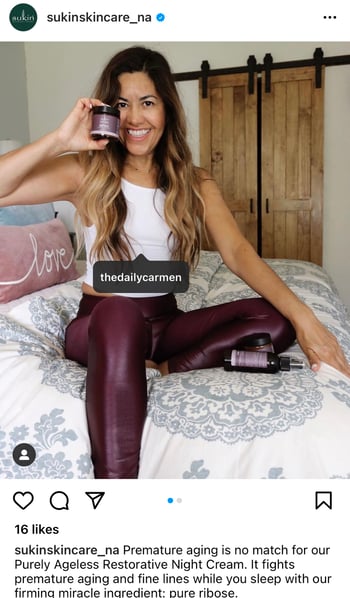
Source: @sukinskincare_na
Not only do people want to see content from fellow customers but they also love getting shouted out themselves! Reposting UGC is such a meaningful touchpoint between you and your customers.
When someone tags you in a photo or video, you’ve also earned a powerful piece of marketing content for your brand. This is especially true if you plan to run ads using your UGC or influencer content.
If you can scale your customer content and republish it frequently, you’ll create a greater sense of community with your audience.
Whew! That was a lot of ground to cover, right?
Mastering skincare social media involves a lot of moving pieces. At the end of the day, proving your brand’s positive results for customers should be your top priority.
And making that happen means having hundreds of creators posting about your brands.
The challenge? Getting that authentic, customer content at scale without sacrificing quality.
The beauty industry is competitive. That's the ultimate understatement. That's also why having a high volume of creator content is an absolute must-do. Quality is also crucial when competition is so fierce.
That's where a platform like Statusphere can save the day. Our scalable micro-influencer solution has generated 100,000+ pieces of authentic content for our brands.
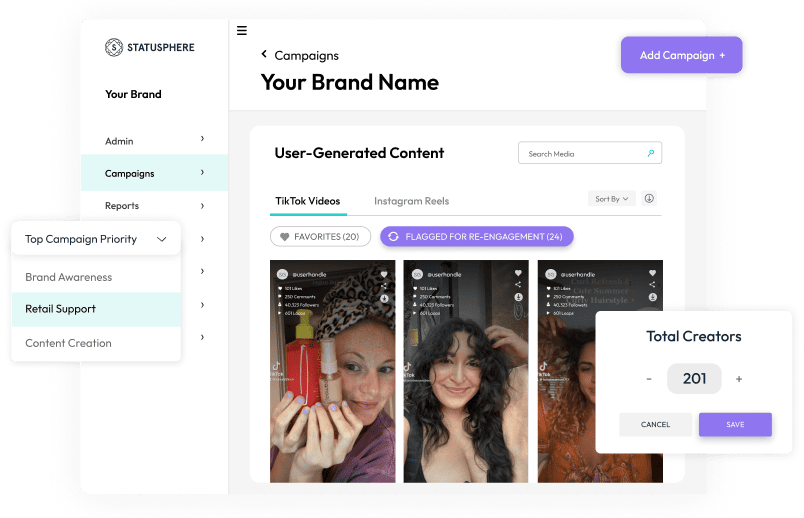
Our advanced matchmaking algorithm is especially useful for skincare brands. That's because we match brands and creators based on 300+ unique, first-party data points. For example, our platform can match your brand with makeup influencers based on skin conditions, skin type and preferred beauty products.
Since you only get matched with vetted micro-influencers from our network, your products always get into the hands of people who actively want to post about your brand. With Statusphere, brands get guaranteed content from authentic creators at scale.
Want to see how the platform works? Get in touch with one of our experts to see how we can help you scale your influencer marketing efforts in a fraction of the time.
This article was first published in July 2022. It was last updated March 9, 2025.
Finding makeup influencers is an ongoing process for beauty brands in constant need of UGC. We dig into how to find beauty content creators for any...
Is there such a thing as the best type of UGC for brands? We rank our top four examples of user-generated content and dig into why each type is so...
Looking for examples to inspire your UGC strategy? We dig into eleven of the best user-generated content examples we've seen recently and why they...
Be the first to know about the latest tools, trends and strategies in influencer marketing for brands.